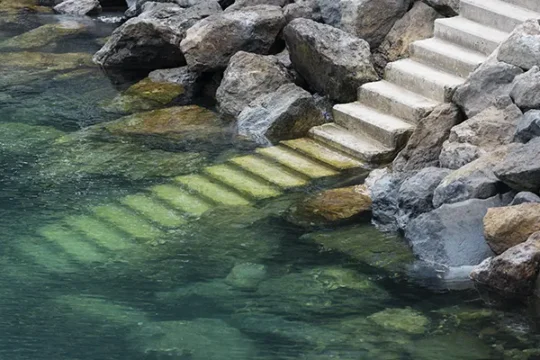TABLE OF CONTENTS
Nothing’s more frustrating than watching your artificial rock waterfall turn from a powerful cascade into a sad trickle. You spent good money creating that dramatic water feature, and now it barely flows. Here’s the thing—weak pressure usually means something specific went wrong with your pump, plumbing, or the waterfall structure itself. The good news? Most of these problems are fixable once you know what to look for.
Common Causes Behind Weak Waterfall Flow
Clogged Pump Components Block Water Movement
Your pump impeller gets clogged faster than you’d think—we’re talking 40-60% reduced flow in just a year or so. Leaves fall in, calcium builds up, even small pebbles somehow find their way into the pump housing. The impeller (that’s the spinning part with blades inside your pump) can’t move water efficiently when it’s wrapped in debris.
And if you live in Orange County or anywhere with hard water, you’ve probably noticed that white crusty stuff building up everywhere. That’s calcium carbonate, and it loves to narrow your pipes from the inside out. Water around here tests between 180-250 mg/L for hardness—high enough that you’ll lose 15-30% of your flow just from mineral deposits over time.
Undersized Plumbing Restricts Water Flow
Here’s something that surprises people: going from 2-inch pipe to 1.5-inch cuts your flow almost in half. It seems like a small difference, but water physics doesn’t work that way. If your waterfall needs 80 gallons per minute through proper 2-inch pipes, those skinnier 1.5-inch pipes will choke the flow badly.
Sometimes contractors cut corners on plumbing to save a few bucks during installation. You won’t notice right away—the system works okay at first. But after a couple years when your pump isn’t quite as strong as it used to be, those undersized pipes become a real problem. For most waterfalls, you want 2-inch pipes minimum if the run is under 50 feet. Longer runs or multiple features? Go with 2.5-inch.
Air Trapped in Lines Creates Pressure Problems
Ever notice your waterfall pressure drops randomly? Air trapped in the pipes could be your culprit. When your plumbing runs uphill before reaching the waterfall, air gets stuck at those high points. Those air bubbles compress under pressure and basically steal energy that should be pushing water over your rocks.
The fix is pretty straightforward—you need air relief valves at those high spots. They let the trapped air escape automatically. Without them, you might think your pump is dying when really you just have an air problem.
Pump-Related Issues Affecting Performance
Running your variable-speed pump on low to save electricity? You might be cutting your water flow in half. A lot of homeowners don’t realize that their 2-HP pump running at 50% speed delivers way less water—basically equivalent to a tiny 0.75-HP pump. Your waterfall needs somewhere between 60-100 gallons per minute to look impressive. Dial down that pump speed and you’re sacrificing the whole dramatic effect you installed it for.
Pump seals wear out too. When they start going bad, water leaks internally and just recirculates inside the pump housing instead of shooting out to your waterfall. You can lose 10% efficiency before you even notice something’s wrong. Most pumps need new seals every 4-6 years or so, but people often overlook this and blame other parts of the system.
Then there’s the electrical side. If your wiring is too thin for the distance it’s covering, your pump isn’t getting full power. Picture this: you’ve got a 2-HP pump pulling 20 amps through wire that’s really only rated for 15 amps, and it’s running 100 feet from your panel. That pump is losing 8-12% of its voltage before it even starts working. It runs, sure, but never at full strength. A good electrician can tell you if your wire gauge is the problem.
Check Valve Problems That Steal Pressure
Check valves gone bad can waste 20-35% of what your pump puts out. These valves are supposed to be one-way doors—they keep water from flowing backward when the pump shuts off. But when that internal flapper gets old or something gets stuck in there, water starts flowing the wrong direction even when the pump’s running. You’re literally pumping water in a circle.
Spring-loaded check valves steal 3-5 PSI just to open them. That’s pressure loss before water even leaves your equipment area. A lot of older systems have these valves when they don’t really need them—modern setups with good plumbing design work fine without them. Pull out an unnecessary check valve and boom, instant pressure boost.
Multiple valves make it worse. If you’ve got two valves that each need 4 PSI to open, you’ve just lost 8 PSI total. For a waterfall that needs 15 PSI at the top, losing more than half to valves means you get that weak, disappointing flow. Worth checking your plumbing to see if you’ve got these pressure thieves hiding in there.
Waterfall Spillway Design and Maintenance
If your spillway opening is narrower than 18 inches, you’re going to get streams instead of that nice sheet of water. The size of the opening where water comes out of your rock structure makes a huge difference in how it looks. A 12-inch opening needs 90-120 gallons per minute to create a solid curtain of water. An 18-inch opening? Only needs 60-80 GPM from your existing pump for the same effect.
The lip where water flows over needs to be dead level too. If one section is even 1/4-inch higher than the rest, water takes the easy route and flows over the lower spots. You end up with dry patches that look terrible. Good installers use levels and shims to get everything within 1/8-inch—that’s the kind of precision that matters.
Algae buildup is sneaky. That green slime creates friction that actually holds water back through surface tension. It prevents that smooth sheeting action you want. Pressure wash your spillway a couple times a year and you’ll keep the water flowing right without touching any equipment.
Diagnosing the Root Cause
Want to know where you’re losing pressure? Measure your flow at the pump and again at the waterfall. You can use pressure gauges if you have them, or just grab a 5-gallon bucket and a timer. Fill the bucket at your spillway and time it. Takes 60 seconds? You’re getting 5 gallons per minute. Compare that to what your pump should be putting out—a 2-HP pump on high should give you 75-100 GPM. Big difference means you’ve got a problem somewhere in between.
Walk your plumbing line and look for leaks. Wet spots, white mineral stains, or soft muddy ground near your pipes are dead giveaways. Even a small crack—we’re talking 1/4-inch—can lose 10-15 gallons per minute. Mark anything suspicious so a pro can check it out properly.
Listen to your pump when it’s running. Hear rattling or grinding sounds? That’s called cavitation, and it means air is getting in or something’s damaged inside. It sounds like marbles bouncing around in there. Don’t ignore that noise—it means you need help before the whole pump gives up.
Solutions for Restoring Full Water Pressure
Cleaning your pump basket and impeller is probably the easiest fix and brings back 30-40% of your pressure in most cases. Turn off the breaker first (seriously, don’t skip this), pop off the pump lid, and pull out whatever’s stuck in the basket. For the impeller, you’ll need to open the pump housing itself. If you’re handy with tools, you can do it. If not, better to call someone who knows what they’re doing.
Replacing pump seals is trickier. You need the right tools and you have to get everything back together exactly right. Mess it up and you’ll have leaks worse than before. Professional techs knock this out pretty quickly and usually warranty their work, so that’s worth considering.
Upgrading your plumbing from small pipes to bigger ones means digging. It gets rid of the flow restriction permanently, but you need a good assessment first to figure out the best way to do it. Good news is that pros can use directional boring to run new 2.5-inch lines without tearing up your whole yard or patio.
Preventing Future Pressure Loss
Put a leaf canister before your pump and you’ll catch debris before it reaches the impeller. These big cylindrical filters grab 90% of leaves and junk before they cause problems. Your pump will last 3-5 years longer. Just clean the canister out weekly during fall when leaves are dropping like crazy.
Do a quick monthly walk-around. Look for wet spots along your plumbing, listen for weird pump noises, watch how your waterfall flows. Takes maybe 10 minutes once a month and catches most problems before they turn into expensive emergencies.
Get a pro out twice a year for real maintenance—pressure tests, flow measurements, the whole thing. They’ll spot stuff like bearings starting to wear out or seals that are going bad months before everything breaks. Way cheaper than emergency repairs when your pump dies on a Saturday night.
Restore Your Waterfall’s Power Today
Look, a weak waterfall is frustrating. You didn’t spend all that money on your artificial rock setup just to watch water dribble down pathetically. Most pressure problems come down to stuff that’s actually pretty straightforward once you know what you’re looking at—clogged pumps, pipes that are too small, or parts that wore out.
We’ve fixed hundreds of these issues around Orange County. Our techs show up with actual testing equipment, measure everything, and figure out exactly what’s killing your pressure. No guessing games.
Contact us now and we’ll come check out your waterfall system. We’ll test the flow, look at all your components, and give you a real plan to get that dramatic cascade back. Give us a call at 949-691-3845 or book online—we can usually get out there within a couple days.




